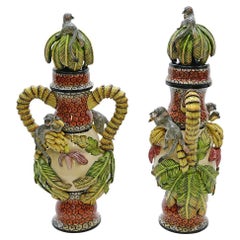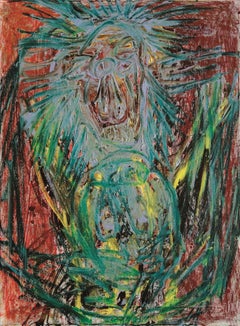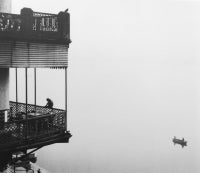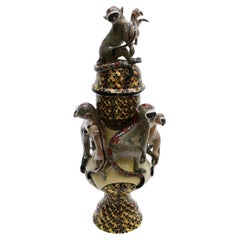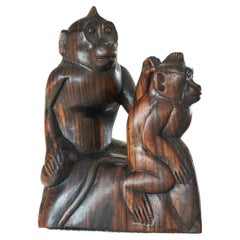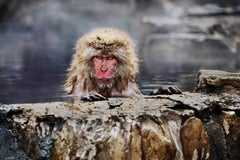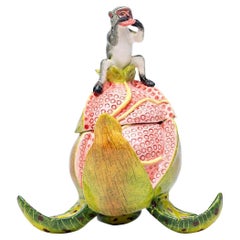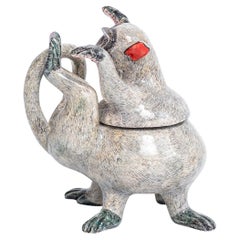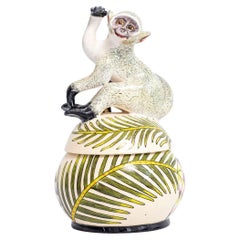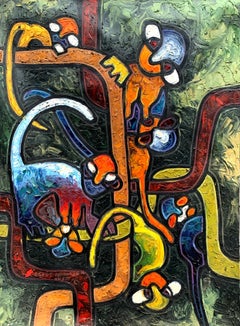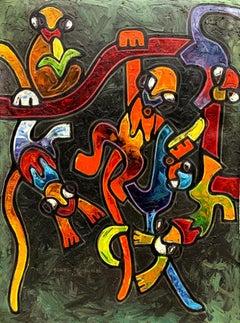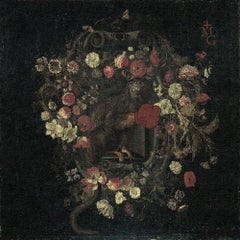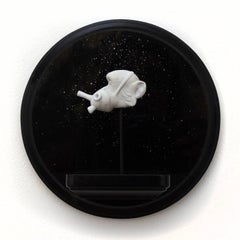Monkeys In Art
2010s Contemporary Mixed Media
Leather
21st Century and Contemporary South African Modern Urns
Ceramic
2010s Expressionist Figurative Paintings
Canvas, Oil
20th Century Photography
Silver Gelatin
21st Century and Contemporary South African Modern Urns
Ceramic
Early 20th Century Unknown Art Deco Animal Sculptures
Wood
2010s Color Photography
Archival Pigment
21st Century and Contemporary South African Modern Jewelry Boxes
Ceramic
21st Century and Contemporary South African Modern Jewelry Boxes
Ceramic
21st Century and Contemporary South African Modern Decorative Boxes
Ceramic
21st Century and Contemporary Contemporary Figurative Paintings
Canvas, Oil
21st Century and Contemporary Contemporary Figurative Paintings
Canvas, Oil
21st Century and Contemporary Contemporary Figurative Paintings
Canvas, Oil
2010s East Asian Folk Art Sculptures and Carvings
Stone
21st Century and Contemporary Contemporary Figurative Paintings
Oil
Vintage 1950s Austrian Mid-Century Modern Decorative Art
Brass
Early 20th Century Tribal Figurative Sculptures
Wood
1920s Expressionist Figurative Prints
Lithograph
1920s American Impressionist Landscape Paintings
Oil, Linen
Early 20th Century Japanese Meiji Sculptures and Carvings
Bronze
Antique 15th Century and Earlier Indonesian Antiquities
Stone
Vintage 1970s Mexican Art Nouveau Animal Sculptures
Brass
1990s Contemporary Black and White Photography
Archival Pigment
Antique Late 19th Century Chinese Antiquities
Porcelain
Antique 1880s Japanese Meiji Sculptures and Carvings
Wood
Antique Late 19th Century Japanese Meiji Sculptures and Carvings
Bamboo
Early 20th Century French Art Deco Animal Sculptures
Bronze
Early 20th Century American Arts and Crafts Doors and Gates
Wrought Iron
Recent Sales
21st Century and Contemporary Contemporary Mixed Media
Cotton Canvas, Archival Ink
2010s Contemporary Sculptures
Glass, Wood, Paint, Plate Glass
Oil
1950s Contemporary Black and White Photography
Black and White
1950s Black and White Photography
Photographic Paper, Lithograph
17th Century Paintings
Oil, Panel
1950s Contemporary Black and White Photography
Black and White
Vintage 1960s Italian Mid-Century Modern Toys
Rubber
21st Century and Contemporary Post-Modern Animal Paintings
Canvas, Oil
21st Century and Contemporary South African Modern Jars
Ceramic
21st Century and Contemporary South African Modern Animal Sculptures
Ceramic
Early 20th Century German Toys
Metal
21st Century and Contemporary South African Modern Jewelry Boxes
Ceramic
21st Century and Contemporary South African Modern Jewelry Boxes
Ceramic
21st Century and Contemporary South African Modern Jewelry Boxes
Ceramic
21st Century and Contemporary South African Modern Jewelry Boxes
Ceramic
21st Century and Contemporary South African Modern Jewelry Boxes
Ceramic
21st Century and Contemporary South African Modern Jewelry Boxes
Ceramic
21st Century and Contemporary South African Modern Jewelry Boxes
Ceramic
Vintage 1930s American Toys
Early 20th Century Japanese Paintings and Screens
21st Century and Contemporary South African Modern Jewelry Boxes
Ceramic
21st Century and Contemporary Contemporary Abstract Paintings
Canvas, Oil
Early 18th Century Baroque Animal Paintings
Canvas, Paint, Oil
Antique Mid-19th Century Japanese Edo Paintings and Screens
Gold Leaf
18th Century Still-life Paintings
Oil
Early 20th Century American End Tables
Iron
Antique 1880s German Black Forest Sculptures and Carvings
Walnut
Antique Mid-19th Century British Victorian Figurines and Sculptures
Sterling Silver, Gilt Metal
Vintage 1910s Danish Art Nouveau Vases
Early 20th Century African Art Deco Jackets
Vintage 1930s French Chandeliers and Pendants
Iron
20th Century French Art Deco Animal Sculptures
Glass
Vintage 1970s French Art Deco Screens and Room Dividers
Wood
Vintage 1930s French Art Nouveau Tableware
Early 20th Century French Art Deco Animal Sculptures
Bronze
Vintage 1920s Danish Art Deco Jars
Ceramic
1960s Contemporary Figurative Photography
Photographic Paper
Late 20th Century Modern Animal Paintings
Oil
2010s Symbolist Figurative Paintings
Canvas, Acrylic
20th Century Abstract Animal Paintings
Oil
Antique Late 19th Century American Adirondack Sculptures and Carvings
Iron
Early 1900s Animal Paintings
Oil, Wood Panel
Antique 1870s Japanese Boxes and Cases
Copper
Vintage 1920s Danish Art Deco Barware
Brass, Steel
Vintage 1940s Japanese Decorative Objects
Wood
21st Century and Contemporary Pop Art Figurative Sculptures
Bronze
1980s American Modern Animal Drawings and Watercolors
Paper, Ink
People Also Browsed
Vintage 1970s Danish Scandinavian Modern Chandeliers and Pendants
Aluminum
2010s Italian Mid-Century Modern Table Lamps
Brass
2010s Contemporary Nude Photography
Archival Paper, Photographic Paper, C Print, Color, Polaroid
Vintage 1950s Hong Kong Hollywood Regency Table Lamps
Brass
Antique 19th Century Busts
Bronze
2010s Contemporary Black and White Photography
Archival Paper, Photographic Paper, C Print, Color, Polaroid
Kirsten Thys van den AudenaerdeGirl - Contemporary, Nude, Women, Polaroid, 21st Century, Color, 2019
Antique 17th Century French Tapestries
Wool
Mid-20th Century Landscape Paintings
Oil
Early 2000s Expressionist Portrait Paintings
Canvas, Oil
21st Century and Contemporary Italian Modern Candlesticks
Ceramic
Antique 1870s French Napoleon III Floor Lamps
Bronze
Early 20th Century Impressionist Landscape Paintings
Canvas, Oil
21st Century and Contemporary Italian Modern Candlesticks
Ceramic
1980s Impressionist Figurative Paintings
Canvas, Oil
16th Century Figurative Paintings
Oil, Wood Panel
21st Century and Contemporary Vietnamese Modern Commodes and Chests of D...
Metal
- 1stDibs ExpertApril 5, 2022The three wise monkeys represent the idea that a person should see no evil, hear no evil and speak no evil. This imagery comes from a Japanese saying and grew in popularity during the 17th century. On 1stDibs, find a variety of art and decorative objects depicting the three wise monkeys.
- 1stDibs ExpertApril 5, 2022The origin of the three wise monkeys comes from a Japanese saying that translates to "speak no evil, see no evil and hear no evil." A carving over the door of the Tōshō-gū shrine in Nikkō, Japan, produced during the 17th century is one of the earliest known visual representations of the concept. On 1stDibs, find a selection of art and decorative objects depicting the three wise monkeys.
- 1stDibs ExpertJanuary 19, 2025The famous Danish wooden monkey is a work by designer Kay Bojesen. He became world-famous for creating wooden toys that had a soulful presence and an impish sense of humor. With more than 2,000 pieces to his name, he was one of Denmark's most prolific artisans in the 20th century. He is best known for his playful and cheerful monkeys. Find a selection of Kay Bojesen pieces on 1stDibs.
- 1stDibs ExpertApril 5, 2022A server would use a monkey dish to present nuts and other small finger foods and condiments. The name comes from the centuries-old practice of giving a small portion of food to a monkey to determine if it was poisoned. Shop a collection of monkey dishes on 1stDibs.
- What kind of art is Western art?1 Answer1stDibs ExpertApril 5, 2022Western art can reference art made in the American West, typically at the end of the 19th century. It can also reference any type of art that comes from the “west,” meaning a region that shares a European tradition, including the United States and Canada. On 1stDibs, find a variety of original artwork from top artists.
- 1stDibs ExpertFebruary 21, 2024In contemporary art, conceptual art is a movement that began in the 1960s. Artists producing conceptual art assign more importance to the idea behind the art than to the piece itself. An example is Joseph Kosuth’s One and Three Chairs, a piece consisting of a real chair, a photograph of a chair and the dictionary definition of the word chair. When the work was displayed, Kosuth included instructions for any chair to be photographed and then displayed beside its image. In this way, the chair itself is not the artwork. Rather, the art comes from examining the way the object, image and words provide competing and complementary definitions of what a chair is. Find a large selection of fine art on 1stDibs.
- What type of art is KAWS’s art?1 Answer1stDibs ExpertFebruary 13, 2024Many people consider KAWS’s art type to be Pop art. The style first emerged in the 1950s. In stark contrast to traditional artistic practice, Pop art’s practitioners drew on imagery from popular culture, using things like comic books, advertising, product packaging and other commercial media to create original paintings, prints and sculptures that celebrated ordinary life in the most literal way. In his work, KAWS similarly appropriates pop phenomena like Mickey Mouse, the Smurfs, the Simpsons and SpongeBob SquarePants. Shop a selection of KAWS art on 1stDibs.
- 1stDibs ExpertSeptember 25, 2019
Fine art is a category of art comprising works with purely aesthetic purpose, as opposed to applied art, which serves a practical function.
- Is mandala art folk art?1 Answer1stDibs ExpertApril 22, 2024Yes, mandala art is folk art. The definition of folk art is art that reflects the sociocultural characteristics and values of a particular group of people. Mandala art fits this definition due to its association with the Hindu and Buddhist faiths. On 1stDibs, explore a selection of folk art from some of the world's top sellers.
- Where do art collectors buy art?1 Answer1stDibs ExpertMay 30, 2024Art collectors buy their art from a few places. They may attend auctions to bid on works or attend gallery exhibitions to purchase pieces. Some arrange to buy art through dealers, while others shop on trusted online platforms to find paintings, prints, sculptures and other works. Explore a diverse assortment of art on 1stDibs.
- 1stDibs ExpertSeptember 25, 2019
Fine art denotes work of aesthetic value but no functional purpose, whereas decorative art is both visually appealing and functional.
- 1stDibs ExpertSeptember 25, 2019
The term contemporary is applied to art by 21st-century artists; modern art refers to works created from the1880s and through the 1960s.
- What is figurative art?1 Answer1stDibs ExpertSeptember 25, 2019
Figurative art is representational, depicting subjects found in the real world.
- What is fossil art?1 Answer1stDibs ExpertMay 5, 2023Fossil art is a real fossil that has been mounted in a way that allows you to display it as a decorative accent. Some fossil art hangs on a wall, while others rest on tables like sculptures. Shop a selection of fossil art on 1stDibs.
- What is a diptych in art?1 Answer1stDibs ExpertFebruary 22, 2021A diptych is a piece of art, either painting or relief, made up of two parts connected by hinges so they can be closed like a book. Diptychs are small in size, often used as an altarpiece for private prayers.
- What is a brayer in art?1 Answer1stDibs ExpertMay 3, 2024In art, a brayer is a printmaking tool. It consists of a rolling cylinder mounted on a metal frame attached to a handle. Printmakers use it to spread ink over a printing plate. You may sometimes see people refer to brayers as ink rollers or ink spreaders. Find a large selection of art prints on 1stDibs.
- What is shipibo art?1 Answer1stDibs ExpertApril 5, 2022Shipibo art is the term for artwork produced by the Shipibo-Konibo indigenous peoples who live in the Amazon River Basin area of Peru. Their artisans make elaborate textiles, jewelry, wood carvings and ceramics. On 1stDibs, shop a variety of shipibo art.
- What is a collagraph in art?1 Answer1stDibs ExpertFebruary 27, 2024In art, a collagraph is a print produced via a process known as collagraphy. To produce one, an artist glues or seals objects onto wood or paperboard to produce an image and create a printing plate. Then, they apply ink and use the plate to transfer the image onto another surface. Printmaker Glen Alps developed the technique and unveiled it in 1956. Find a large collection of art prints on 1stDibs.
- What is a cityscape in art?2 Answers1stDibs ExpertFebruary 22, 2021Also called an urban landscape, a cityscape in art is a painting, print, drawing or other representation of an urban area.Irena Orlov ArtMarch 1, 2021It is an artistic representation of the physical aspects of an urban area or cities. Its features are a high population density, extension and major constructions made by human beings: houses, buildings, carts, roads, factories, squares. Lifestyles can also be appreciated.
- What is a print in art?1 Answer1stDibs ExpertMay 30, 2024In art, a print is a work produced multiple times by transferring an image from a plate to another surface. Making a print can be as straightforward as pressing a painted surface against another surface or as complex as triggering a chemical reaction to create an image. Artists embrace different techniques to yield various effects: some printing techniques, like etching, emphasize lines, for example, while others, like lithograph printing, are better for creating soft textures. On 1stDibs, shop a diverse assortment of art prints.

